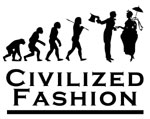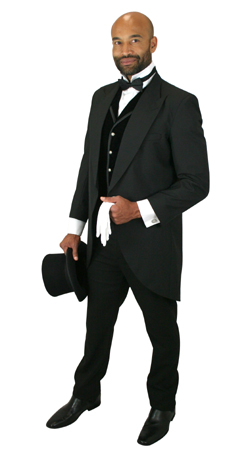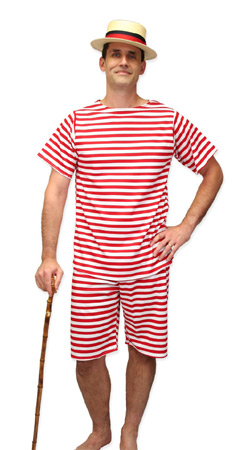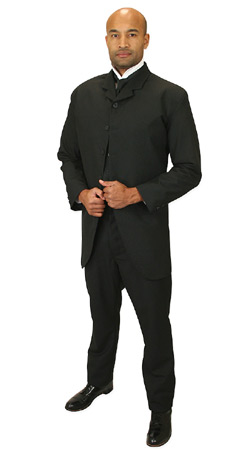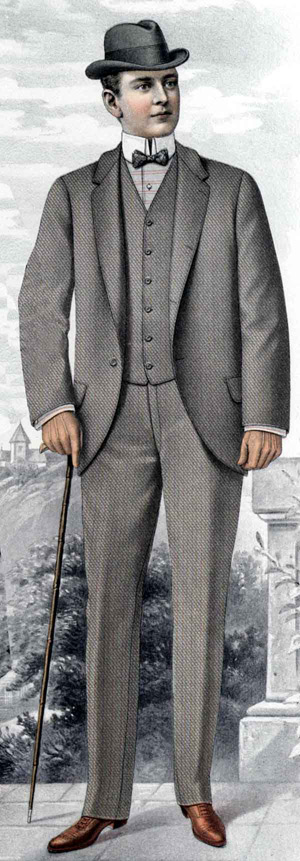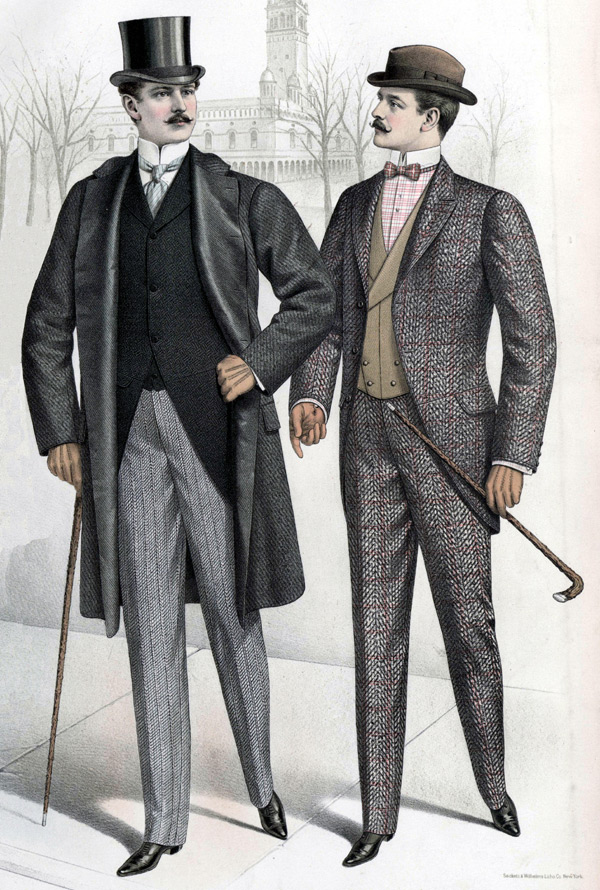Prices and Availability Subject to Change. Please call 800-997-4311 for more Information.
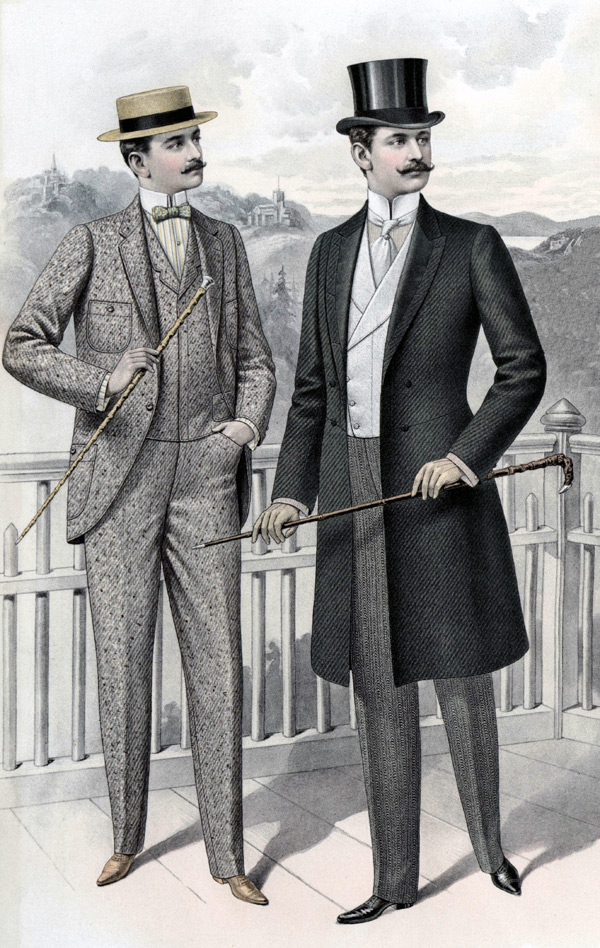
Mens Edwardian Clothing (1890s - 1920s)
As the Victorian Era came to a close and power passed to Prince Edward VII, an unmatched age of elegance and over-the-top opulence ensued --- it was the last hurrah of luxury and leisure in the new century before The Great War. While women's fashion changed dramatically, day and evening wear of the Edwardian gentleman remained quite the same with slim and tightly fitted looks in dark colors keeping favor - only small tweaks in tailoring, cuts of jackets, collar styles and such were of discernable notice.
However, a big boom was seen in apparel to dress a man for endeavors of sports and fitness - and of course, a fitting and fashionable outfit was de rigueur for every endeavor. While fox hunting, yachting and polo were in favor with aristocracy and men of considerable means, the efficiencies of a more modern society afforded the middle class time to pursue leisure activities such as golf, tennis, basketball, croquet, tennis, swimming and bicycling. Tennis whites, swimwear and knickers were in high demand. Bicycling became the "it" activity for nearly everyone, with bicycle ownership in the US growing from 200,000 to 1 million in just 10 years, and paved the proverbial road for the expansion of roads and advances in transportation.
As the 19th century came to a close, advances in science and technology, as well as the historical and geographic discoveries of the late victorian, led to a general feeling of optimistic modernity. This manifested in the day's fashions, with men's garments continuing the previous trends of slim and tightly fitted looks for both day and evening wear.
Formal events still called for opulent, traditional styles, but mens' daywear at the turn of the century was business-like and very matter-of-fact, with many of the Victorian frills falling away to leave the styles that inform fashion even today.
Edward, the Playboy Prince, died in 1910 and with him came the end of an era. War was soon to sweep the continent and bring changes to attitudes, beliefs and fashion. Though day to day fashion changed, the influence of the era is still visible in men's suits, ties and evening wear.
Learn MoreComplete Edwardian Outfits
We offer a full line of men's period clothing which are suitable for movie and TV production, theatrical, living history and performing arts requirements, and are also perfect for vintage weddings!
All of the products we sell are sold individually, but we have put together these full outfits to showcase the elements of Edwardian style for your consideration and inspiration.
Click any image for a close-up and a list of the products shown.

Elements of Edwardian Style
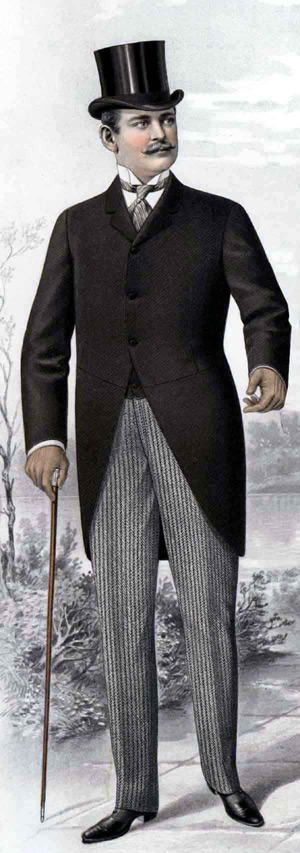
During the Edwardian era, especially in the States, the preferred demeanor of manliness was that of robust, healthy masculinity - the image was significantly less fastidious and fussy than the early Victorian years dominated by dandies and bluebloods. This was influenced greatly by the rise in sports and outdoor activities as well as the admiration and mimicry of real-life characters such as then sitting President Theodore Roosevelt. Not only did Roosevelt establish the National Park system, encouraging adventure for the everyman, but his own personal exploits in the Rough Riders, on safari and in travels around the world were well documented for consumption by the populace.
Edwardian Coats - By the 1890s, most mens' coats were mass produced and distributed directly to retail stores across the US, although the wealthiest still dabbled in custom tailoring. Sack coats were the preferred pick, especially as the 1900s progressed, but other styles were still seen for more formal occasions. The frock coat, now usually slim and double-breasted in the "Prince Albert" style was the most conservative option, and increasingly seen as old-fashioned; morning (cutaway) coats were the preferred choice for most when formal daywear was required.
Regardless of the style, colors were generally dark, and a man was safe, sartorially speaking, in a black three-piece suit, now called a "lounge suit". By the Edwardian era however, sporting wear and even dress for watching spectator sports allowed for a different look. Lounge suits of light colored flannel or linen, or a striped blazer with white trousers, were popular in the summer and often topped with a straw boater hat. Although the individual garments did not change very much after the adoption of the lounge suit as standard daywear, silhouettes gradually relaxed over this period from the tightly fitted, buttoned-high coats of the turn of the century, towards a more loosely fitted, boxier silhouette by 1910, with lower necklines and wider lapels.
For evenings, the classic black tailcoat was still very much the measure of elegance, worn open with matching trousers, a stiffly starched white shirt with tall collar and small bow-tie and a low, U-cut vest in black or white matching the tie. tailcoats of this era could have shawl or notched collars. The look was finished by a long elegant coat, perhaps an Inverness cloak or Chesterfield, and a black top hat. For the young and fashionable, the tail-less tuxedo coat, appearing on the scene in the late Victorian years, found continued favor. Again with a choice of shawl or notched collar, it was worn with the same shirt, vest and tie ensemble as the tailcoat, perhaps with the fashionable Homburg hat.
Overcoats - A smart overcoat of wool or cashmere, worn over the lounge suit was the height of Edwardian elegance, and there were plenty of options from which to choose. The Chesterfield (knee length, single breasted fly front) was still popular, as was a type of wide-lapelled double breasted "surtout". Another style of overcoat popular since the 1890s was the Covert topcoat, originally a hunting/riding coat.The Covert was single breasted with a fly front, and cut just a few inches longer than the sack coat worn beneath it, and was made from "covert" cloth in shades of tan.
A coat truly of this period is the car coat - born out of the need for a thick warm overcoat which would protect the wearer, and garments underneath from weather, dust and mud while travelling in open top cars. In summer, dusters were often still worn to protect clothing. Car coats would be worn with gloves, goggles and caps.
Edwardian Vests - Vests were still an essential part of a man's look in the early 20th century, and followed coat styling with high necklines and slim cut lapels and the turn of the century, relaxing to lower necklines and wider lapels later on. Most often a part of the three piece suit for day wear, while it could match the coat and pants, a vest was also one of the few allotments for color for a gentleman so inclined.There was also a wide variety of styles to choose from at this time; single or double breasted, shawl or notched collar, or collarless, but all with hems sloping down to a point at the front waist, a style that became more exaggerated in the 1910s. Evening wear required a particular type of vest cut in a U or V shape, which would show off the stiffly starched white shirt front or dickie. These could be single or double breasted, most often with a silk shawl collar and black or white depending on the occasion.
Edwardian Shirts - As in the previous Late Victorian Era, shirts typically featured detachable collars and cuffs, which allowed the wearer to alter the shirt's appearance by swapping out collars. The fashion for extremely tall stand collars continued, but high stand wingtip and banker collars were also under every chin, also most often very tall until the 1920s approached. Although soft-fronted shirts were introduced in this era, they would not be widely adopted until the 1920s - starched shirt fronts were worn with all types of suits. Detachable collars, cuffs and even shirt fronts helped maintain a tidy presentation considering the infrequency of laundry day - although that started changing near the end of the era thanks to the invention of the electric washing machine (1907), and shirts began to look much more like the mens' shirts of today. Many shirts also featured a stud closure on the front which gave gentlemen another outlet for expressing fashion sense.
White was a predominant color for shirts, and certainly required for evening and formal wear. Polka dots, double stripes and single stripes were also popular however, although most often only the collar and cuffs of a shirt would be seen under coat and vest.
Edwardian Trousers - Trousers in the early 20th century continued the earlier fashion for a narrow cut, but shortened generally, sometimes to ankle length, and could be worn with a turn-up for a young, fashionable look. A sharp central crease was fashionable, possible now since the invention of the electric trouser press. The cut of the trousers loosened after 1910, as the overall silhouette became boxier again.
While co-ordinating three-piece suits were prolific in business and casual social settings, be it plain black, brown or grey, or striped, checks or tweeds, a black or grey morning coat for formal daywear could also be worn with pair of grey-and-black striped trousers. Most pants of this era continued to feature a button fly and suspender buttons, and knickers (buttoned or elasticized under at the knee) were popular for sporting participation, often worn with a Norfolk jacket. The 1920s saw the development of the "plus-fours", a looser, baggier style of knicker that bloused out over the top of the sock or boot. Inspired by the loose riding pants worn by British officers during WW1, and popularized by the glamorous Edward, Prince of Wales, this style required adding 4 inches of fabric to the usual length of knickers and was offered as an option in most catalogs through the 20s and 30s.
Edwardian Hats - A proper gentlemen wouldn't head outside without a hat and retailers offered a variety of styles to suit every situation. While tall black top hats continued to be required for evening occasions, they were falling out of favor for day wear. Derbies, Homburgs, a stiff felt hat with a central crease, and Straw Boaters ruled the day, as did wool caps and wheel hats for sporting and leisure events and informal daywear. Working men could be seen wearing all of these styles, in addition to the newsboy cap. With the advent of the automobile, caps, gloves and goggles were often worn to increase comfort while driving.
Edwardian Ties - Bowties, ascots and four-in-hand ties were all worn during the Edwardian era. The Joinville scarf was an extremely popular tie of the era - a 6 " wide, almost yard-long piece of fabric, often with lace or fringing, knotted at the neck and could even be worn with a finger ring under the knot for added glamour. While hand-knotted ties were worn, ready-made bowties, ascots and four-in-hands were extremely common, to ensure a pleasing appearance with minimal fuss, and a variety of tie clips and frames were used to keep ties in place on the tall collars of the time.
As one of the permitted "pops" of color in a period of conservative, somber colors for menswear, ties could be extremely brightly colored and patterned, and offered a rare opportunity for self-expression in dress.
Edwardian Sportswear - Although the three-piece suit remained the standard for menswear, the popularity of various sport and leisure pursuits and the garments developed for them; cardigans for tennis, cricket and baseball; woolen sweaters for automobiling; Norfolk jackets and knickers for golf, hunting, and country leisure; led to these styles being increasingly acceptable for casual daywear as the 20th century rolled on.
Shop Complete Outfits Return to Top



